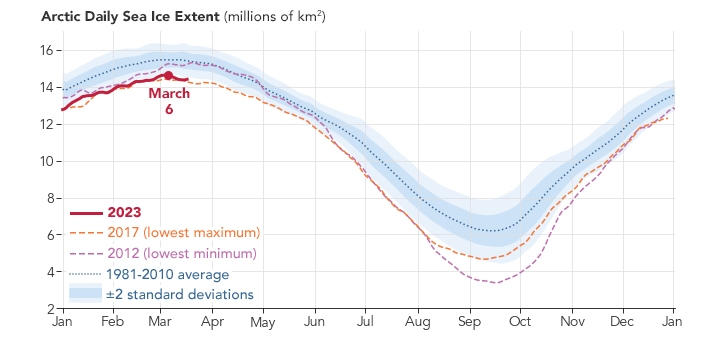

After growing through the fall and winter, Arctic sea ice appeared to reach its annual maximum extent on March 6, 2023. This year’s end-of-winter extent was the fifth lowest in the satellite record maintained by the National Snow and Ice Data Center.
Arctic sea ice extent peaked at 14.62 million square kilometers (5.64 million square miles), a total area that is roughly 1.03 million square kilometers (398,000 square miles) below the 1981–2010 average maximum. Compared to the average maximum, the Arctic Ocean in winter 2023 was missing an area of ice equivalent to the states of Texas and Arizona combined.
The map above shows the ice extent on the day of its annual maximum. To determine extent, scientists project satellite observations of sea ice onto a grid and then add up the total area of each cell that is at least 15 percent ice-covered. The yellow outline shows the median sea ice extent for February from 1981–2010. A median is the middle value; that is, half of the extents were larger than the yellow line and half were smaller.

Since the start of the satellite record in 1979, the ten lowest maximums have all occurred since 2006. According to Angela Bliss, a sea ice scientist at NASA’s Goddard Space Flight Center, this is partly because the summer melting season has grown longer over the past few decades. A longer melting season allows the ocean to absorb more sunlight, which adds heat to the ocean and further reduces ice growth during the following autumn and winter.
Now that the 2023 annual maximum has been reached, weather conditions will largely control how the ice beaks up and melts during the spring and summer, according to Bliss, who studies the seasonal cycles of Arctic sea ice. It remains to be seen how much melting will occur and how quickly the ice will reach its minimum extent, which usually happens sometime in September. But long-term trends for this sea ice metric also point downward—the past 16 years (2007 to 2022) have seen the 16-lowest minimum extents.
“Low minimums are typically seen as more important than low maximums because the minimums are directly tied to how much multi-year ice survived in a given year in the Arctic,” said Nathan Kurtz, a sea ice scientist who leads the Cryospheric Sciences Laboratory at NASA Goddard. “The long-term trend towards lower minimums means an overall loss of multi-year ice, which has significant impacts to the climate.”
NASA Earth Observatory images by Lauren Dauphin, using data from the National Snow and Ice Data Center. Story by Kathryn Hansen. Video produced by Jefferson Beck with visualization by Trent Schindler, NASA’s Goddard Space Flight Center/Scientific Visualization Studio.
The end-of-winter sea ice extent in March 2023 was the fifth lowest in the satellite record.
Image of the Day for March 22, 2023